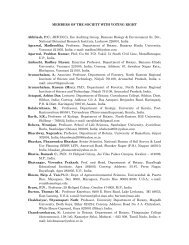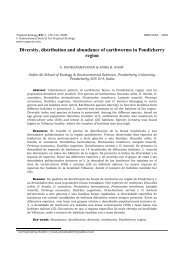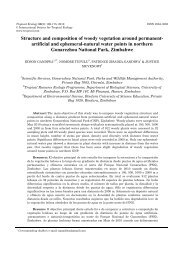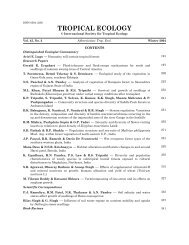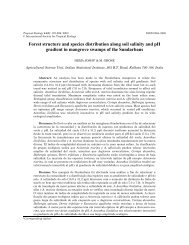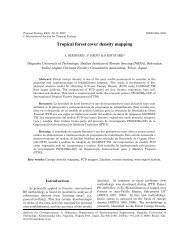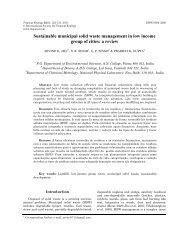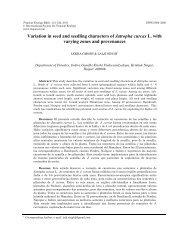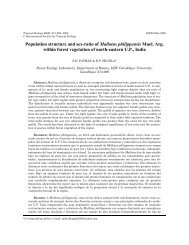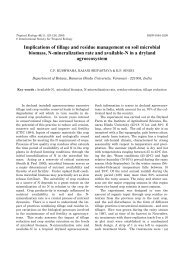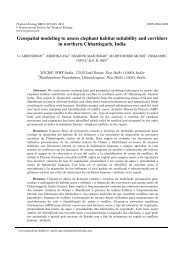Spatial heterogeneity of the soil seed bank in the tropical semi ...
Spatial heterogeneity of the soil seed bank in the tropical semi ...
Spatial heterogeneity of the soil seed bank in the tropical semi ...
You also want an ePaper? Increase the reach of your titles
YUMPU automatically turns print PDFs into web optimized ePapers that Google loves.
PERERA 83due to abundance <strong>of</strong> Ageratum conyzoides <strong>seed</strong>s, acharacteristic feature <strong>of</strong> <strong>the</strong> <strong>soil</strong> <strong>seed</strong> <strong>bank</strong> <strong>of</strong> <strong>the</strong>ecotone.Seeds <strong>of</strong> forest species were, ma<strong>in</strong>ly, present<strong>in</strong> <strong>the</strong> forest <strong>soil</strong> <strong>seed</strong> <strong>bank</strong> although a few <strong>of</strong><strong>the</strong>m were also found <strong>in</strong> <strong>the</strong> <strong>soil</strong> <strong>seed</strong> <strong>bank</strong> <strong>of</strong> <strong>the</strong>forest-grassland ecotone (Table 1). They were,however, hardly found <strong>in</strong> <strong>the</strong> grassland <strong>soil</strong> <strong>seed</strong><strong>bank</strong>. Most <strong>of</strong> <strong>the</strong> typical grassland species werefound <strong>in</strong> <strong>the</strong> forest <strong>soil</strong> although <strong>the</strong>y were found<strong>in</strong> <strong>the</strong> <strong>soil</strong> <strong>seed</strong> <strong>bank</strong>s <strong>of</strong> <strong>the</strong> grassland and <strong>the</strong>ecotone <strong>in</strong> large quantities. When <strong>the</strong> woodyspecies were considered, it became evident that<strong>seed</strong>s <strong>of</strong> <strong>the</strong> most common woody forest specieswere not represented <strong>in</strong> <strong>the</strong> <strong>soil</strong> <strong>seed</strong> <strong>bank</strong>except for Diplodiscus verrucosus (Thw.)Kosterm. and Memecylon umbellatum Burm. f.(Table 2).Density <strong>of</strong> <strong>seed</strong>s <strong>in</strong> <strong>the</strong> surface <strong>soil</strong>Seed densities <strong>in</strong> <strong>the</strong> <strong>soil</strong> varied significantlywith <strong>the</strong> distance form <strong>the</strong> forest grasslandboundary (one way ANOVA: P < 0.001). The mean<strong>seed</strong> density was higher <strong>in</strong> <strong>the</strong> grassland (8339 ±918) and at <strong>the</strong> forest-grassland ecotone grassland(6990 ± 2751)(Fig. 3). However, <strong>the</strong>re was anabrupt decl<strong>in</strong>e <strong>in</strong> <strong>the</strong> densities <strong>of</strong> <strong>seed</strong>s <strong>in</strong> <strong>the</strong> <strong>soil</strong>beyond 5 m distance <strong>in</strong>to <strong>the</strong> forest and <strong>the</strong> density<strong>of</strong> <strong>the</strong> forest <strong>soil</strong> <strong>seed</strong> <strong>bank</strong> was 583 ± 236. Therewas a very high <strong>in</strong>teraction between <strong>the</strong> distanceand <strong>the</strong> transects (blocks), especially <strong>in</strong> <strong>the</strong>Table 1. Distribution <strong>of</strong> typical forest and grassland species (as a percentage <strong>of</strong> <strong>the</strong> total number <strong>of</strong> plots <strong>in</strong> eachcategory) <strong>in</strong> <strong>the</strong> two <strong>soil</strong> <strong>seed</strong> <strong>bank</strong> types and at <strong>the</strong> forest-grassland ecotone.Species category Species Grassland<strong>in</strong>teriorFrequency (%)Forest-grasslandecotoneForest <strong>in</strong>teriorForest species Diplodiscus verrucosus 0 5 19Peperomia pellucida 0 10 38Flueggea leucopyrus 0 35 75Walsura trifoliolata 0 0 25Grassland species Ageratum conyzoides 33 85 38Phyllanthus amarus 8 10 7L<strong>in</strong>dernia crustacea 58 75 19Desmodium triflorum 25 55 0Oldenlandia herbacea 42 60 0Ocimum canum 25 25 6Scoparia dulcis 50 25 7Mimosa pudica 67 55 31Table 2. Dom<strong>in</strong>ant woody species <strong>in</strong> <strong>the</strong> stand<strong>in</strong>g vegetation and <strong>the</strong> on <strong>the</strong> <strong>soil</strong> (Species <strong>in</strong> each category arearranged <strong>in</strong> descend<strong>in</strong>g order <strong>of</strong> abundance).Forest vegetation (studied by Jayas<strong>in</strong>gham 1991)Dimorphocalyx glabellus, Mallotus rhamnifolius,Glycosmis sp., Polyalthia kor<strong>in</strong>ti, Diospyrosovalifolia, Diplodiscus verrucosus, Memecylonumbellatum, Drypetes sepiaria, Catunaregamsp<strong>in</strong>osa, Phyllanthus polyphyllusSoil <strong>seed</strong> <strong>bank</strong> estimated by <strong>the</strong> current studyForest <strong>in</strong>teriorFlueggea leucopyrus, Chromolaena odorata, Diplodiscusverrucosus, Memecylon umbellatum, Salacia oblonga, Walsuratrifoliolata, Phyllanthus reticulatusForest - grassland ecotoneFlueggea leucopyrus, Chromolaena odorata, Phyllanthusreticulatus, Diplodiscus verrucosusGrassland <strong>in</strong>teriorAristolochia <strong>in</strong>dica, Calotropis gigantea





